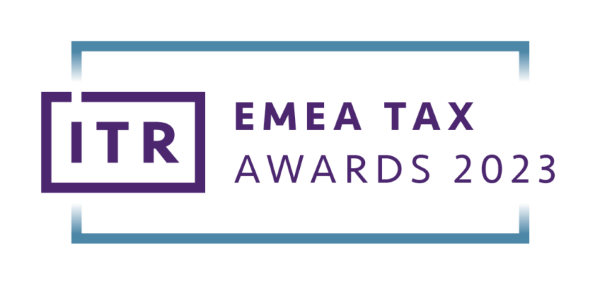Cyprus Tax considerations for the year ahead
EY Cyprus recognized by International Tax Review as National Transfer Pricing Firm of the Year for the fifth consecutive time
For the fifth consecutive year, EY Cyprus is named as the Transfer Pricing Firm of the Year by the International Tax Review in recognition of the high-quality tax services offered.

Partner, Head of EY Cyprus Tax and Legal Services | EY Cyprus
We are delighted to introduce our Tax & Legal newsletter for the year ahead, which provides a holistic view of recent and forthcoming changes in Cyprus and the EU. Cyprus has adopted new legislation that make it an attractive business destination. Some other changes (such as DAC7) relate to tax transparency while other changes relate to Green Taxation which is a new reality. If you would like more information or would like to organize a meeting with our team, please feel free to reach out.
-
Transfer Pricing
Transfer Pricing
Cyprus introduced transfer pricing rules and documentation requirements effective as of 1 January 2022 in line with the OECD TP Guidelines. The new rules require domestic and cross-border intra-group transactions to be documented for Cypriot TP purposes.
During 2023, the Cyprus Tax Authorities ("CTA") released FAQs which address a number of aspects relating to the application of the new TP legislation. Also, during 2023, the CTA issued a tax circular introducing simplification measures for various types of intercompany transactions that do not fall within the ambit of TP documentation thus effectively introducing certain safe harbour rates. In addition, the CTA issued a tax circular taking the position that as of 2023 tax year, the Comparable Uncontrolled Price is the preferred method for documentation of back-to-back financing transactions, while the use of other methods can only be accepted in exceptional circumstances and provided certain conditions are met.
Additional changes and guidance are expected in 2024. As businesses operate in an interconnected global economy, transfer pricing has become an increasingly important aspect both in terms of tax compliance and tax planning. It is expected that transfer pricing will be very high on the list of priorities for both tax authorities and taxpayers alike.Charalambos Palaontas
Partner, International Tax and Transaction Services | EY Cyprus
-
Corporate Tax
Introduction of 15% Global Minimum Tax – Pillar II On 15 December 2022, the Council of the EU (i.e., the EU Member States) unanimously adopted the Directive ensuring a global minimum level of taxation (15%) for multinational enterprise (MNE) groups and large-scale domestic groups in the Union (the “Directive”). The Directive provides a common framework for Member States to implement into their national laws the Model Rules on the Pillar Two Global Minimum Tax (GloBE), as agreed by the G20/OECD Inclusive Framework on Base Erosion and Profit Shifting (BEPS) 2.0. and released on 20 December 2021.
The global minimum tax rules set out in the Directive were expected to be transposed into the domestic legislation of the EU Member States and be in effect as of 31 December 2023. Cyprus has not yet transposed the rules into the domestic legislation but is expected to do so in the next couple of weeks with a retroactive effect as of 31 December 2023.
The rules introduce a minimum effective tax rate (ETR) of 15% to MNE or large-scale domestic groups with consolidated annual revenues of €750 million in at least two of the four fiscal years immediately preceding the tested fiscal year. The Directive sets forth a system consisting of two interlocked rules - the Income Inclusion Rule (IIR) and the Undertaxed Profit Rule (UTPR) - through which an additional amount of tax called a “top-up tax” should be collected each time that the ETR due on the income of an MNE or domestic large-scale group in a given jurisdiction is below 15%. In such cases the jurisdiction is considered to be low tax.
Under a qualified IIR, the parent entity of an MNE or large scale domestic group located in a Member State (or in a third country that has introduce the rules) should be obliged to apply the IIR to its share of top-up tax relating to any entity of the group that is low-taxed, whether that entity is located within or outside the EU.
The UTPR should act as a backstop to the IIR – which means that in case the top-up taxes relating to low-taxed entities could not be collected by parent entities through the application of the IIR, there is a reallocation of any residual amount of top-up tax to the entities that are located in jurisdictions that have introduced the UTPR rules based on tangible assets and employees costs.
Cyprus is expected to introduce an IIR for financial years beginning on or after 31 December 2023 and the UTPR for financial years beginning on or after 31 December 2024.
The Directive also includes an option for the Member States to introduce their own domestic minimum top-up tax based on the Pillar Two mechanics in order to preserve their primary right of taxation over its own income. In such case, in case a qualified domestic minimum top-up tax is introduced, it will reduce the amount of top-up taxes collected through IIR or UTPR. Cyprus is expected to introduce a domestic minimum top-up tax for financial years beginning on or after 31 December 2024.
Various safe harbors have also been developed by the OECD which provide relief from the rules for a specified period of time provided certain conditions are met. Cyprus has consented to these safe harbors through a public statement made by the Minister of Finance.
Eleni Papachristodoulou

Director, International Tax and Transaction Services | EY Cyprus
Petros Krasaris
Partner | Head of International Tax and Transaction Services
Phone: +357 22 209 790
Guidance on the application of the interest limitation rules
In 2023, the Cyprus Tax Authorities issued a tax circular providing guidance on the application of the interest limitation rules. The said rules were introduced in 2019 as part of the adoption of the EU Anti-Tax Avoidance Directive. Following the release of the tax circular, the tax authorities are expected to place more emphasis on this matter and thus taxpayers are encouraged to ensure compliance with the rules.
Michalis Karatzis

Senior Manager, International Tax and Transaction Services | EY Cyprus
Cyprus | Update of EU List of non-cooperative jurisdictions may trigger withholding tax and other implications
On 17 October 2023, at the Economic and Financial Affairs Council, the European Union (EU) Finance Ministers approved the revised list of non-cooperative jurisdictions (EU List). The EU List is relevant for tax purposes since as of 31 December 2022, Cyprus imposes withholding tax on dividend, interest and royalty payments made to entities that are registered or resident in a jurisdiction that is included in Annex I of the EU List. In addition, the EU List is relevant for MDR and Public CbCR purposes since under certain conditions, payments to these jurisdictions may create a reporting obligation.
The Cyprus Tax Authorities are in the process of issuing a circular providing clarifications on the application of withholding tax on dividend, interest and royalty payments made to entities that are on the EU list.
Olga Chervinskaya

Senior Manager, International Tax and Transaction Services | EY Cyprus
Additional Defensive Measures based on Cyprus' National Recovery and Resilience Plan
As per Cyprus' National Recovery and Resilience Plan, Cyprus committed to introduce defensive measures in relation to low tax jurisdictions. Such a legislative change will enter into effect by 31 December 2024. Based on discussions with the relevant authorities, it is expected that Cyprus will introduce withholding taxes on outbound payments of dividend made to low tax jurisdictions. Moreover, it is expected that Cyprus will introduce provisions as per which the deductibility of interest and royalty payments made to low tax jurisdictions will be denied under certain conditions.
Elina Papaconstantinou

Senior Manager, International Tax and Transaction Services | EY Cyprus
-
Exchange of information and tax transparency
Cyprus enacts law implementing tax transparency rules for digital platforms (DAC7)
On 3 November 2023, the law requiring the automatic and mandatory exchange of information reported by platform operators comes into force, with the first reports to be filed with the Cyprus Tax Authorities no later than 16 February 2024 (further to an extension which was granted).
The law also introduces certain changes to the existing legislation on administrative cooperation in tax matters and amends the common reporting standard (CRS/DAC2) and DAC6 laws to comply with data protection requirements.Panayiotis Tziongouros
Partner, International Tax and Transaction Services | EY Cyprus
Cyprus DAC6/MDR rules in full effect with increased enquiries from the tax authorities
We have eventually completed the third year during which the rules on the automatic exchange of information on reportable cross border arrangements, encompassed under the relevant DAC6/MDR legislation are in full effect. Intermediaries and relevant taxpayers should in principle be in a position to identify, assess and report reportable arrangements but also should be in a position to document their compliance efforts by maintaining appropriate books and records for their cross border arrangements. Failure to comply with the aforementioned requirements may amount to hefty penalties.
The past year also marked increased activity from the Cypriot Tax Authorities (“CTA”), evidencing that the enforcement of exchange of information frameworks is at the forefront of their priorities. A number of Cypriot taxpayers and intermediaries received several information requests requiring additional information, clarifications and documentation for submitted arrangements in relation to different elements of reporting. In addition, the information requests of the CTA relating to the application of ‘’safe harbor’’ rules (Forms T.D155) and the revision of the EU’s list of non-cooperative jurisdictions have been intrinsically connected with reportable cross border arrangements.The ongoing revamp of the Directive in Administrative Cooperation with the possible introduction of new hallmarks and the continuous efforts of the CTA for an effective enforcement of the rules render the need to comply with the rules as timely as ever.
Stavros Karamitros

Manager, International Tax and Transaction Services | EY Cyprus
New Cyprus Tax Treaties with the Netherlands and Croatia effective as of 1 January 2024
The tax treaty between Cyprus and the Netherlands (“CY-NL Treaty”) entered into force on 30 June 2023 and is effective as of 1 January 2024. The CY-NL Treaty provides for full relief of withholding taxes on dividend payments to corporate investors, provided they hold directly at least 5% of the capital of the company paying the dividends throughout a 365-day period. This exemption also applies for certain recognized pension funds which are generally exempt under the corporate tax laws of the contracting jurisdictions. The CY-NL Treaty provides for a maximum 15% withholding tax rate in all other cases. Moreover, the CY-NLTreaty provides for 0% withholding tax rate for interest and royalties.
The tax treaty between Cyprus and Croatia (“CY-HR Treaty”) entered into force on 28 December 2023 and is effective as of 1 January 2024. The CY-HR Treaty provides for 5% withholding tax on dividends and royalties if the recipient is the beneficial owner of the relevant income. The CY-HR Treaty provides for 0% withholding tax on interest if the recipient is the beneficial owner of the interest income and if such interest is paid in connection with the sale on credit of any industrial, commercial or scientific equipment, in connection with the sale on credit of any merchandise by one enterprise to another enterprise or on any loan of whatever kind granted by a bank. In all other cases, a 5% withholding tax applies on interest payments.Elina Papaconstantinou

Senior Manager, International Tax and Transaction Services | EY Cyprus
-
Indirect Tax
EU Emissions Trading System
As of year 2024, maritime activities are included in the EU Emissions Trading System (“ETS”). This effectively means shipping companies will need to pay for at least a portion of greenhouse gas emissions generated during voyages to and from the EU.
In addition to underlying costs related to effective compliance with the ETS, new policies and procedures may need to be implemented, in addition to having a dedicated carbon management function.
If the shipping industry were a country, it would be the world’s sixth-largest greenhouse gas emitter. However, when it comes to existing national and subnational carbon pricing regimes, very few address emissions from maritime operations. Where emissions are addressed, it’s in connection with inland voyages. Domestic compliance carbon markets are unlikely to mirror the EU ETS and require maritime operations to bear the associated cost of emissions.
Instead, carbon pricing for the maritime industry is set to be regulated at a global level under the framework being developed by the International Maritime Organization.
Predicting Carbon Pricing Measures
In July, during the 80th session of the Marine Environment Protection Committee, the IMO confirmed its intention to implement global carbon pricing for the shipping industry. The policy is expected to be finalized in spring 2024, adopted in autumn 2025, and take effect in 2027.
Several countries, market participants, and international organizations have developed and submitted policy proposals to the IMO. Proposals range from a global shipping cap-and-trade system (advocated by Norway), to a carbon tax-like mechanism proposed by three different interest groups (Japan, Marshall Islands and Solomon Islands, and the International Chamber of Shipping).
All these proposals involve part of the funding going directly toward rewarding low or zero-emissions ships and voyages. There are significant differences in the level of detail between the proposals, the design and complexity of the schemes, and suggested (if any) amount of the levy.
The IMO can implement one or a combination of these measures. It also could formulate a different design that might not even involve emissions trading or a carbon tax, such as mandatory energy efficiency standards enforced by tradeable certificates, as proposed by the US.
Aviation’s Head Start
When considering what the maritime industry might do, it’s worth looking again at the aviation industry. A global carbon pricing regime has existed for the aviation sector since 2016, namely the Carbon Offsetting and Reduction Scheme for International Aviation, or CORSIA. Participation in the scheme will become mandatory for flights, with very few exceptions, starting in 2027.
This system doesn’t put a price on carbon per se, but instead requires airlines to offset their emissions through the purchase of credits. One credit represents one metric ton of reduced or removed carbon dioxide or other greenhouse gas equivalent, and the underlying activity can take place outside of the aviation value chain.
CORSIA maintains a list of the types of credits that it will recognize per compliance period in relation to their issuing body, which can be either a public or private entity: for example, a national government such as China’s GHG Voluntary Emission Reduction Program, or a private standard such as the gold standard and Verra.
As long as credits are considered eligible, the price at which they were acquired isn’t relevant. This provides regulated entities with a significant level of control over the ultimate compliance costs, but in parallel, compels them to enter and operate in a new marketplace dedicated to carbon offsets.
Unlike the EU ETS, this market has a global reach with little or no regulatory oversight. However, this is expected to change. More countries are starting to make policy interventions, and a global carbon market framework is emerging under the Paris Agreement. It remains to be seen whether the IMO will follow the lead of CORSIA and include offsetting in its carbon pricing design.
How Much Is at Stake
The three carbon pricing design options outlined above—cap-and-trade, tax, and offsetting—can lead to vastly different levels of financial exposure. If the IMO opts for a carbon tax or levy, levels can be set as desired, and some proposals are reaching new heights ($637 per metric ton by 2040 in Japan).
For emissions trading schemes, authorities have some influence over the price and can introduce corrective measures, such as with price floors and ceilings. But the marketplace essentially determines the price, and as of September 2023, the EU ETS price is approximately $90. In voluntary carbon markets, the cost of an offset is the result of its attributes, including geography where the project was developed, type of technology, and standard that issued the offset.In a recent report, the World Bank indicated that carbon pricing in international shipping could raise between $1 trillion and $3.7 trillion by 2050, and that this revenue should support shipping decarbonization, enhancing maritime transport infrastructure and broader climate aims.
Regardless of the route chosen by the IMO, it’s essential for shipping companies to understand the role of carbon markets—especially the role they can play in reducing the emissions footprint of voyages as “companies want to buy decarbonized shipping now.”
Trading in carbon offsets requires careful consideration and understanding of their complex legal, tax, and accounting nature, how policy trends impact their monetary value, public perception of offsets, and the potential related mandatory and voluntary claims.
Simos Simou
Senior Manager, Indirect Tax | EY Cyprus
EU | Compliance obligations for EU CBAM
On 1 October 2023, the transitional period of the Carbon Border Adjustment Mechanism (CBAM) entered into force. During the transitional phase, importers, their representatives and brokers and certain other parties in the supply chain are required to adhere to several compliance and reporting requirements that may vary depending on the Member State of importation.
Simos Simou
Senior Manager, Indirect Tax | EY Cyprus
Central Electronic System of Payment information (CESOP): Less than a month to go
The Council Directive (EU) 2020/284 alongside Council Regulation (EU) 2020/283 introduced new recording and reporting obligations for Payment Service Providers (PSPs) providing payment services within the EU, applicable as of 1 January 2024. In Cyprus, it is expected that an implementing legislation will be enacted in the coming weeks.
The new regulations are designed to tackle VAT fraud, enabling national authorities of each Member State to perform investigations. The information collected by different Member States will then be exchanged between them and centralized in a European database, Central Electronic System of Payment information (CESOP). This data exchange will enable tax authorities to detect potential VAT fraud, by identifying sellers behind websites or marketplaces.Georgios Mavroyiakoumos

Assistant Manager, Indirect Tax | EY Cyprus
-
Employee Related Μatters
Change to Social Insurance
Social Insurance Contribution Rates
As of year 2024, the Social Insurance Contribution rates for both of the employer and the employee are increased by 0,5% and for self-employed individuals by 1%. The below table summarizes the contribution rates which are applicable for the year 2024:Self-employed individuals
16,6 %
Employee’s contribution
8,8 %
Employer’s contribution
8,8 %
Employer’s contribution to the Redundancy Fund
1,2 %
Employer’s contribution to the Human Resource Development Authority Fund
0,5 %
Employer’s contribution to the Social Cohesion Fund
2 %
Maximum limit of emoluments
As of year 2024 the below maximum amount of emoluments are applicable for Social Insurance Contribution purposes:
Weekly
Monthly
Yearly
€
€
€
Weekly employees
1.209
64.077
Monthly employees
5.239
62.868
Social Cohesion Fund
An employer is liable to pay a social cohesion fund contribution of 2% on the amount of the emoluments of his employees (without any restriction as to the amount of the emoluments).

